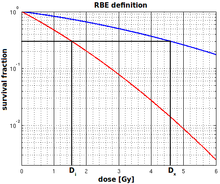Relative biological effectiveness

The relative biological effectiveness , short RBW (ger .: relative biological effectiveness , RBE ) is Radiobiology a distinguishing factor for radiation types in terms of their biological effects.
The same physical radiation dose can develop different biological efficacy with different types of radiation. Reasons for this can be the different texture of the tissue, the different temporal dose rate or the different local dose distribution ( linear energy transfer , LET) and ionization density of the radiation.
definition
The relative biological effectiveness is defined as the ratio of the absorbed dose D ref of a reference radiation, which causes a certain biological effect, to the dose D Y of another radiation, which is necessary for the occurrence of the same effect f under the same conditions on the same biological object:
The RBE generally depends on the dose applied, the linear energy transfer (LET) and the type of damage observed.
Dependence on linear energy transfer
Radiation with a large LET, i.e. radiation of heavy, charged particles, generates more ionizations per volume (ionization cluster) than radiation with a low LET. In the human body, this leads to an increased probability of double-strand breaks in the DNA, which can only be removed with difficulty or not at all by the cell's own repair mechanisms.
The relative biological effectiveness increases as a function of the linear energy transfer with the same dose initially continuously up to a maximum at about , and then falls sharply. The reason for this is that radiation with a very high LET deposits more energy in a cell than is necessary for its biological inactivation; so-called overkill occurs .
Dependence on the observed effect
Frequently occurring direct radiation effects are local damage to the DNA .
- X-rays produce about 1000 single strand breaks (ESB) per cell and gray , whereas alpha radiation produces 1000 single strand breaks per cell at about 4 gray. So the RBW value is the alpha radiation for the generation of single strand breaks
- .
- X-rays produce about 35 double-strand breaks (DSB) per cell and gray, alpha radiation produces 35 double-strand breaks per cell at a dose of about 0.56 Gray. The RBW value of the alpha radiation for the generation of double-strand breaks is therefore
- .
Determination and results
The RBW is determined experimentally. For this purpose, the effects of several types of radiation on the survival rates of different organisms such as bacteria , eukaryotes or rats are compared. A low LET radiation such as X-rays from an X-ray tube with an anode voltage of 250 kV or the gamma radiation of 60 Co with energies of 1.17 MeV and 1.33 MeV is usually used as the reference radiation .
Similar doses of photon and beta radiation usually lead to similar effects in the irradiated organism, so they have a similar biological effectiveness, while irradiation with neutrons , ions or alpha particles causes significantly more severe damage. Depending on the radiation energy, the biological effectiveness for these particles is between two and twenty times as high as that of X-rays.
Relation to the dose equivalent
The relative biological efficacies for different tissues and organisms are fundamentally not comparable and must therefore be determined or estimated separately. However, since this procedure is usually not practicable and experiments, especially on humans, would not be ethically justifiable, radiation weighting factors w R are specified in radiation protection based on the known effectiveness , which allow a dose-independent comparison of the various types of radiation. With the introduction of the equivalent dose, uniform limit values can be set for all types of radiation, taking into account the effectiveness.
The radiation weighting factors do not represent physical measurands, but are merely standards for simplified handling in radiation protection. In Germany they are normatively defined in the Radiation Protection Ordinance.
literature
- H. Krieger: Fundamentals of radiation physics and radiation protection. 3rd edition, Vieweg + Teubner, 2009, ISBN 3-8348-0801-6 , limited preview in the Google book search




